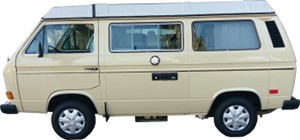
RV Basics
There is a lot to the systems that make up even your most basic RV. It can all be a little overwhelming for the uninitiated. But relax, everyone has been new to this once. To help you along the links below and the graphic describe the basic systems of an RV. It does not matter if your rig is a multi-million dollar rolling palace, or a home made wooden camper for your Toyota truck, you will have a variant of these systems.
Infrastructure
Self sufficiency and freedom are part of the allure of living on the road. Learning and understanding the systems that make travel easier and more comfortable provide both of these. A vehicle equipped to travel over long periods will have its own infrastructure. This infrastructure consists of things that most of us take for granted and are often invisible in our homes. These things are power, light, water, a way to cook, a place to store valuables, clothes, and a shelter for protection from the elements. An RV or vehicle equipped for traveling will have these systems, and they require maintenance and service. It is also pretty handy to be able to fix things if they beak down while you are on your dream trip.
RV Basics map
Click on the graphic to learn about the systems that make up a vehicle designed for travel. We have used a trailer, but these systems are same for campers RV’s and some vans and cars. There is a list of links below the graphic covering the same information.
Links To The Ten Recreational Vehicle Basics
Energy Systems
Lighting
Cooking
Water Systems
Ventilation Systems
Heating and Cooling
Awnings and Shades
Wheels and Axles
Towing
Levelers
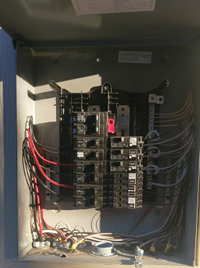 Energy Systems
Energy Systems
Staying warm or cool, having light to read, being able to cook and have hot water are all things that require energy. Energy in our homes is usually delivered invisibly through transmission lines and gas pipes. In an RV these systems are not nearly as transparent. Typically an RV will have a combination of energy sources.
Electricity
Like your home an RV will have electricity but usually it will be 12Vdc rather than 120Vac that runs your house. The source will vary also. Electricity will come from the vehicle motor, solar panels, sometimes even wind turbines. If you have access to ac it will come from a generator or you will have to plug in to the grid. Once produced, energy needs to be stored. This is almost always done with batteries.
Direct Current, (DC), Batteries
Your vehicle uses batteries to start, run lights and the various electrical systems that allow it to run. Vehicle designed to travel usually have extra batteries. These will be isolated from the main battery to prevent it from running down and then not being able to start the vehicle. Extra batteries add capacity for lights, running fans, charging and running phones and laptops.
RV batteries are usually lead acid type batteries. These are very robust, and very heavy. To avoid expensive replacements and to increase battery life it is important to maintain them. Lithium ion batteries are becoming more widely used as well. They are lighter, and deliver more energy for their weight, meaning you can increase capacity while reducing space and weight. Lithiun Ion batteries are still expensive and use more sophisticated chargers. They can be very dangerous if mishandled or damaged, (so can lead acid batteries).
All batteries are DC, (direct current), and are usually 12vdc, (there are exceptions to every rule). This means that there needs to be a DC source to charge them. Your vehicle has a DC charging system that can charge auxiliary batteries as long as your engine is running. But, if you are stationary for any period of time it is good to have an alternative way to keep you batteries charged.
Charging Batteries
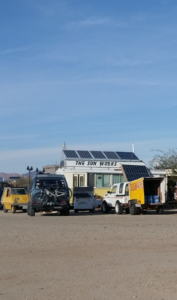 Solar
Solar
Solar has become the primary way to charge secondary batteries. The price of solar panels has dramatically dropped over the last couple of years. This has made them accessible and useful for mobile applications. There is much to be learned about the various solar solutions to battery management. In fact I will be providing several posts covering the basics and more advanced topics of solar. For this article I will just mention the basics.
Why Solar?
Allowing a lead acid battery to become completly discharged is the quickest way to destroy it. Solar at its most basic is a great way to keep a charge on your battery(s) when you are not using them. Batteries will discharge on their own, and they will discharge faster if there is any load on the battery. These loads could be a clock or devices that don’t completely power off, (called phantom loads).
A solar panel can replace the small internal drain of a battery and can make up for the losses of phantom loads, (small ones). This means when you are ready to go on your next trip your batteries will be healthy and fully charged. Anything that is infrequently used, such as boats, cars, motorcycles can benefit from small solar chargers. The cost of the solar panel and charger can re-cooped in the first season by not having to replace expensive batteries.
Solar Chargers
Solar is quickly becoming the primary charging source for auxiliary batteries. All solar charging systems, (with the possible exceptions of the very smallest), require a solar panel and a charge controller. The charge controller regulates how the batteries are charged. They can be as simple as providing a fixed voltage to very sophisticated charging profiles used for high end batteries like Lithium Ion. Additionally the charge controller interfaces with the solar panel. Most controllers are designed to work with your vehicle voltage, 12vdc. They can also work with higher DC voltages and optimize the efficiency of the panels you are using. Solar chargers can be Linear, Pulse Width Modulated, (PWM), or Max Power Point Tracking, (MPPT). As they become more sophisticated they increase in cost.
Solar panels also come in different configurations and voltages. Most panels can be connected to either increase overall current or overall voltage, (or both). This allows expansion of the system as you learn more about your needs. The best way to get started with solar is to buy a small panel and charge controller, then scale up as you learn.
Other Sources
Auxiliary RV batteries are also charged by on-board chargers when connected to the grid, (AC systems), or to a generator.
Wind turbines are also used. They must be set up when you arrive and then put away when you are traveling.
Alternating Current, (AC)
Most RV’s have an AC system. You simply plug in at an RV park or a convenient outlet and you have all the electrical luxuries of home. Older units used AC devices like lights and TV’s, which meant they were not available for use when the was no AC source. Newer units use more DC devices and have a device called an inverter to convert DC to AC. This provides convenience and utility. It is important to know there are big differences between cheap inverters and pure sine wave inverters. The less expensive inverters can quickly damage sensitive AC devices because of the dirty power, (square wave), they deliver. Pure sine wave inverters deliver a cleaner sine wave that more closely resemble what you get from your power company. If you have valuable AC powered equipment it would be wise to understand the difference between the two types of converters.
Propane and Fuel
Heating, (and cooling), is energy intensive. Propane and CNG have what is known as a high energy density. This simply means that they have a lot of energy per volume. This makes them an ideal fuel for running generators, heating spaces, cooking and heating water. Most RV’s have propane or Compressed Natural Gas, (CNG), tanks on board. These systems are robust and require little maintenance. They do require inspections and awareness however.
Modern RV’s equipped with compressed gas systems with have gas/CO detectors as well as smoke detectors. Make sure batteries are fresh and those warning systems are functioning properly. If you don’t have the detectors already, they can be purchased and installed easily. Familiarizing yourself with the shutoffs and switch over devices is important as well. If there is a leak or problem with the gas system you want to know what to do, and how to shut the system off.
 Lighting
Lighting
The LED has revolutionized the RV travel industry. The industry has been a little slow to adopt LED’s because of existing stock, poor light quality and design. At this point though, almost all new vehicles use LED lighting. If you have an older vehicle you will want to convert your lighting to LED. The reason is that LED’s use about a 1/10th of the power of old fillimented bulbs. The light quality of LED’s has improved dramatically as well.
By using more efficient lighting you can reduce your battery and charging needs. You can also increase the time you can be “off the grid”, without using a generator or AC system to recharge. This has really changed the nature of vehicle travel. The ability to stay in remote locations independent of power infrastructure has opened up the universe of possibilities for exploration.
Tip: When shopping for LED’s pay attention to the warmth of the light. Unlike filament bulbs, which output a full spectrum of light, LED’s have narrow frequency bands, (color). More expensive, quality LED’s will have frequencies that produce a warmer light. It might be worth sampling several types of LED’s to see which ones you like.
Cooking
Having a clean place to cook while on the road is a real luxury. Technology has only changed this a little. Propane systems still dominate stoves and ovens. If you have a generator or access to AC you can use microwaves as well.
One place that technology has improved cooking is induction stoves. These do not use open flames, and only heat the pan that you are using. You have to use a ferromagnetic pot or pan such as cast iron. You also need a clean AC power source such as that provided by a pure sine wave inverter or AC source such as a generator or the grid. The benefits are these stoves don’t have open flames, do not use gas, they heat only what you are cooking in and take up much less space. This makes them ideal for small spaces, cars vans, small campers.
The drawback of induction cooking is the expense of needing to purchase a pure sine wave inverter and the electrical energy they use. Solar charging and increased battery capacity can overcome the energy use however.
Water Systems
Fresh Water
Clean water is essential for safe, comfortable travel. A water system can vary from carrying plastic jugs to having a large on board water tank. Purpose built RV’s have dedicated water tanks that can carry ten to a hundreds of gallons of fresh water. Water needs to be kept fresh. If allowed to sit for long periods it can become compromised by algae and contamination. Most maintenance headaches can be avoided by not storing water for long periods and using domestic water supplies to keep the tanks fresh . If water becomes contaminated the tanks can be flushed out and treated using chlorine. The easiest way to avoid problems is to stay on top of maintenance.
Water Pumps
Water needs to get from the tank to the point of use. This is accomplished on small systems with a hand pump. On larger systems a pressurized water system is used. A pump with a pressure sensitive switch is used to pressurize the system. When a faucet is turned on the pressure drops and activates the pump. A leak in the system will drain the tanks quickly. Also the pump can be damage once the tanks have been drained. Knowing where the fuse for the water pump, (and everything else), is a good thing to know. Knowing how to shut off the main battery power to the RV is a good alternative, (this is an essential piece of information). If your auxiliary batteries, (main RV batteries), do not have a master shutoff, one should be installed.
Waste Water
Once you have used the water for cooking, cleaning, or the bathroom you need to be able to capture it for proper reclamation. RV’s typically have grey water tanks and black water tanks. Cars, vans and campers should use a container to capture grey water and they may have a way to go to the bathroom such as a portapotty.
Grey Water
Water that has been used for cleaning and cooking is called grey water. It contains soap and may have organic matter such as debris from cooking, cleaning and washing up. Being mindful of the type of detergent you use can have an affect on how to properly dispose of this water. Conventional wisdom, (and often the law), says that this water should be disposed of in a municipal sewer system or a place with a septic system. Common sense should be used here and the seven principle of leave no trace should be followed.
Black Water
Water generated from disposing of human waste is called black water. This water needs to be disposed of properly into a municipal sewer system or a septic system and is considered a biohazard.
Dump Stations
RV’s have plumbing fixtures that are quite intuitive that allow for the dumping of grey and black water tanks. Most RV parks provide a service to dump these tanks, but at a cost. Sometimes roadside rests will have dump stations as well. These are nice because they allow you to get rid of the extra weight in a convenient way. It is good to keep some latex gloves handy for working with these systems.
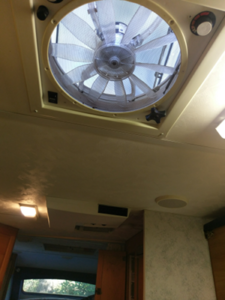 Ventilation Systems
Ventilation Systems
Fans and venting allow fresh air in and stale air out. Good ventilation can often replace expensive air conditioning. Ceiling vents can be equipped with fans. Many are reversible and can be temperature activated. These provide a passive way to keep your mobile living space comfortable. Mobile detachable fans can be used to supplement these fixed systems. While it true that fans use energy, they use far less than air conditioners and usually make an excellent substitute in all but the hottest conditions.
Heating and Cooling
Heaters
Conventional RV heaters use propane and heat exchangers. Often these are what will use up your battery capacity when in cold climates. The fan running all night can use a lot of power. Extra blankets and clothes are a good alternative. Reducing the need for the heater during the night saves fuel and electricity. But you must be cautious of letting your living space temperature dip below freezing. The water systems will no longer work and may be damaged once frozen.
Vans and cars can utilize small propane space heaters. Although in those small and poorly enclosed areas portable gas heaters must be used with extreme caution Carbon monoxide is deadly, odorless and poisoning happens with no warning.
Air Conditioning
Air conditioning requires a large energy source. Power hungry cooling systems must use a generator or be plugged into the grid. A typical solar charging system and battery bank is woefully inadequate to power an air conditioning unit for any length of time. There are mobile swamp coolers that are more efficient, but their effectiveness is dependent on how humid the environment is. If access to AC or a generator is impractical good ventilation can help keep you comfortable.
Refrigeration
Keeping food and beverages cold can cut down on trips to the store and reduce the cost of eating out. Well designed ice chests work for short duration’s but are dependent on your access to ice. The water from the melting ice can also contaminate food. RV’s usually have a refrigerator. Most of these use an ammonia solution that is heated and condensed to remove heat from the refrigerated area. These units are efficient and functional. But they do require a level place to operate properly and also wear out. This is one of the reasons that leveling your vehicle is important when parked for any length of time.
Awnings and Shades
Awnings
Many RV’s come equipped with retractable awnings. These provide shade and shelter from rain and wind. Wind, however, is also a major threat, small gusts can quickly destroy an expensive awning.
Portable Shelters
These come in many sizes and shapes and can be quite useful. Often they are pretty quick to set up and provide shade and shelter. They can come with walls and bug netting to provide additional protection for the elements and bugs. Like awnings they are very susceptible to wind. They should be secured using stakes and tie downs. Being aware of the weather can help avoid disaster.
Tents
Tents can be a great addition to your travel gear. They allow you to sleep outside where it is cooler at night and often they are designed so you can see the night sky. They are useful for short term storage and extra people. Backpacking tents and gear can allow you to go on short or long over nighters to further explore your surroundings.
Wheels and Axles
Tires and Wheels
Often taken for granted are tires. But when you think about the critical role they play in getting you safely across town or across a continent it is apparent how important they are. Traveling long distances exposes the tires of your vehicle to more stress. The vehicle typically is carrying more weight, and often travels on rougher roads. The ability to travel and stay at remote locations means travel on poorly maintained roads. Rocks and debris can make quick work of an inexpensive set of tires. The heat from the road and heavy loads can also quickly destroy tires.
Tires have both speed and load ratings. Purchasing high quality, heavy load rated tires is one of the best insurance policies you can get in terms of safety and convenience. For lighter vehicles the trade off is going with a truck rated tire. These tires may ride stiffer and have more road noise. But the security of having tires that can handle a lot more abuse is more than worth it. As vehicle weight increases so does demands on the wheels and tires and brakes. Dual rear tires can extend tire life, increase traction and spread the load. Adding an extra axle, wheels and tires has the same effect. To improve your safety margin, wherever possible reduce and spread the load out.
Axles
The axles of your vehicle rarely need maintenance. As long as they are not consistently overloaded they should outlast your vehicle. The axles on a trailer require more care. A single axle trailer can be easily overloaded. This causes stress on the tires, axles and bearings. Heat and stress can wear out bearings and grease seals. When the grease seal fails it allows dirt and grime to penetrate into the bearings and races. Once dirt finds its way into the bearing assembly it immediately begins to erode the bearings and races and creates more heat and wear.
Double and triple axle trailers have the same issues. The extra axle(s) and tires help reduce the loading on the bearings, wheels and tires. But, if the trailer is constantly overloaded the life of the bearings and hubs will be much shorter.
Frequent inspections will help you avoid getting stuck on the side of the road with a destroyed hub or tire. If you are right at, or over the load limits of your trailer, increase the inspection interval. A quick visual check can spot leaking grease on the inside of the wheel. This can indicate a failing grease seal. The assemblies should be taken apart occasionally and visually inspected.
Keep a close eye on tire inflation. A low tire will heat up and self destruct. A quick daily inspection around your vehicle can save a lot of money and headaches.
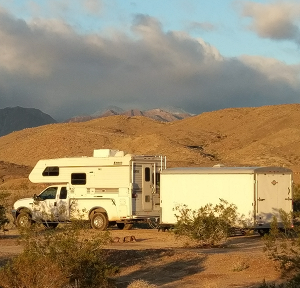 Towing
Towing
Towing takes practice. The most challenging part is backing up. It can be tricky and mistakes lead to costly repairs. The trick to avoiding mistakes is as relevant to beginners as it is to experts; go slow, if in doubt, get out and check it out, use a spotter.
Today’s vehicle are really powerful. This is great if you are in a hurry, it is deadly if you are towing a trailer. Just because your truck can do 70mph up a hill pulling a 15,000lb trailer doesn’t mean you should do it. Trailers are designed to be well behaved on the road. But when they become unstable due to speed, conditions or mechanical failure they can quickly cause the tow vehicle to lose all control. This happens fast, and once a trailer starts oscillating, only extraordinarily skilled and lucky drivers are able to regain control. There are an abundance of YouTube videos out there showing drivers losing control of their trailer. It is worthwhile to watch one or two of these to see if that is an experience you would like to have.
Don’t allow the well designed vehicles and trailers of today lull you into a false sense of security. Traveling is about exploring, and to do that it is important to slow down enough to see what is out there. So to avoid an accident, go slow, enjoy the scenery and maintain your equipment.
Levelers
Trailers, campers and higher end RV’s will have mechanical means to level and stabilize the vehicle when it is parked. This is needed for proper drainage of the water systems, cooking and proper operation of appliances like the refrigerator. It also makes them more comfortable. Knowing this in advance can make it easier to level your vehicle once you have found a place to camp. Develop an eye for flat pieces of ground and parking spots that allow you to level vehicle by raising one corner rather than two.
That’s it!
I hope this has helped de-mystify road travel some. There is a lot to learn about all the above topics. I plan to add blog posts about them and more as time and interest allow. Don’t forget to sign up to our email list for updates and helpful guides, or better yet subscribe! Happy, safe travels, see you out there!

Great info! Inspired. Thank you Mike
Thanks for helping me learn more about RVs. I had no idea that lithium ion batteries are being used more widely now. I’m interested to learn if this has always been the case or if different types of batteries there were mainly used years ago.